Recently, succulents and cacti have become increasingly popular. They are everywhere on Pinterest and social media. Succulents and cacti can make good houseplants because they require very little care as long as they are placed in a location that receives plenty of sunlight.
Here is a list of some of the best succulents and cacti to grow indoors.
Snake Plant
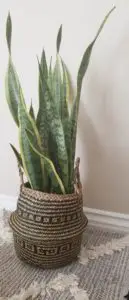
Dracaena trifasciatas, also known as snake plants, seem to grow in popularity, and it is easy to see why. These plants go well with modern-looking decor and are easy to grow indoors.
Put your snake plant in an area that receives indirect sunlight. However, they are tolerant of a variety of light conditions.
Be careful not to overwater your snake plant, especially during the wintertime. To avoid overwatering, allow your snake plant to completely dry out between waterings.
According to the American Society for the Prevention of Cruelty to Animals (ASPCA), snake plant is toxic to cats and dogs. Chewing on the leaves of a snake plant can cause diarrhea and vomiting.
Aloe Vera
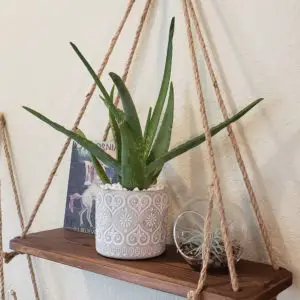
Aloe vera is a great plant to grow indoors because it is easy to care for and is an attractive succulent that can live for several years. In addition, the juice of aloe vera leaves can be used to ease the pain from sunburns.
It is important to note that aloe vera juice should not be ingested by plants or people. It can cause nausea and indigestion.
Like cacti, aloe vera grows best in dry conditions. Plant your aloe vera in cactus potting soil.
Aloe vera needs at least six to eight hours of sun per day. However, aloe vera does not appreciate direct sunlight. To provide your plant with enough light, sit your aloe vera plant in a window that faces east or west.
Rotate your plant every two to three months to ensure the plant is receiving light evenly. This will prevent your plant from leaning toward the light source.
Water your aloe vera plants deeply but infrequently. Make sure the top one to two inches of soil dries completely in between waterings.
Alternatively, you can convert your aloe vera plant to semi-hydroponics (semi-hydro). This is a technique that involves growing your plants in a soil-less medium. The video below describes this process.
Jade Plant
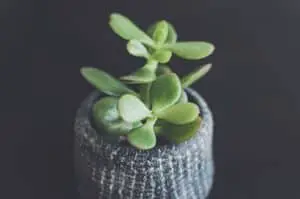
Jade plants, also referred to as money plants or dollar plants, are probably the most popular succulent in the Crassula family. With proper care, these plants may even produce mildly fragrant flowers in late winter.
These plants like a lot of bright sunlight. Ideally, they should be placed near a south-facing window. They should be exposed to four or more hours of sunlight each day.
If jade plants are not exposed to enough light, they can become leggy meaning that the plant looks like it is stretched. Succulents start to stretch or become legging when they are “reaching” for light.
Jade plants should be watered often during the spring and summer. Make sure the soil is moist but not wet. If you press your finger into the soil, it should be spongy rather than muddy. You only need to water jade plants once a week during the winter.
Jade plant is also very easy to propagate from a single leaf. Simply put the leaves in a dish containing soil and cover until the leaves sprout.
Burro’s Tail

Burro’s tail (Sedum morganianum) is a species of succulent that produces long, trailing stems. As a result, they look really stunning in hanging baskets.
Burro’s tail produces tiny flowers seasonally. These flowers may be red, white, or yellow depending on the cultivar.
Unfortunately, these succulents drop leaves easily. Every time you pick up the plant or water it, some leaves may tall off. For this reason, it is best to avoid repotting the plant. Fortunately, burro’s tail can be easily propagated from leaves.
Burro’s tail like bright shade or partial shade light. They should be exposed to at least four hours of light each day. Make sure your burro’s tail is protected from intense sunlight as the scorching sun will burn the leaves.
Only water your indoor burro’s tail once every couple of weeks. Soak the soil thoroughly and allow the topsoil to completely dry out before watering again.
Ruby Ball Cactus
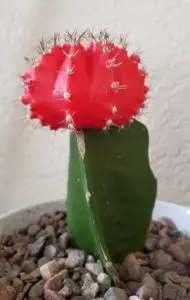
Ruby ball cactus, also referred to as ruby cap and moon cactus is a green cactus with a red ball on top. The red ball is actually an albino cactus (also known as Gymnocalycium) with no chlorophyll grafted onto a green cactus.
The top of the plant cannot survive without being grafted to the green part of the cactus because it has no chlorophyll, which is a chemical necessary for photosynthesis.
Ruby ball cacti are tolerant of low-light conditions. My coworker has been successfully growing a ruby ball cactus at her desk which is not located near any windows.
Place your red ball cactus in an area that gets bright, indirect light. If you expose these cacti to intense sunlight, the color of the top can wash out.
These plants also require very little watering, especially during the winter months. I water my ruby red cactus once a week during the summer and once a month during the winter. Overwatering can cause the top of the cactus to turn brown.
Mini Golden Barrel Cactus
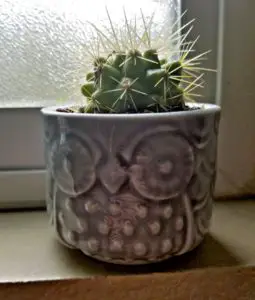
Echinocactus grusonii, which is commonly known as the golden barrel cactus or mother-in-law’s cushion, is a well-known species of cactus that is commonly used in outdoor landscaping. The miniature version is a common indoor plant.
When grown outdoors, golden barrel cacti commonly produce bright yellow flowers. However, they are much less likely to produce flowers when grown indoors.
Like many species of cacti, the golden barrel cactus is drought tolerant and requires very little care. However, they do need to be placed in an area that receives plenty of indirect sunlight. Your golden barrel cactus will turn a pale yellow color if they are exposed to too much sunlight. Ironically, they will have the same reaction if they are exposed to freezing temperatures.
Golden barrel cacti require very little water. I recommend watering your golden barrel cactus once every two or three months. You could probably get away with watering it even less frequently. It is better to err on the side of underwatering rather than overwatering when growing a golden barrel cactus indoors.
The most common health issue with golden barrel cacti is overwatering. These plants die from the inside out, so you may not even know there is an issue before it is too late.
Thanksgiving Cactus
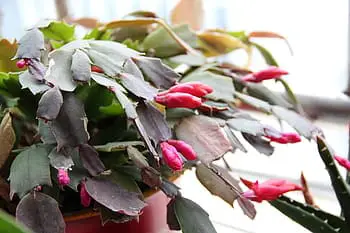
You may be surprised to see Thanksgiving cactus on this list rather than Christmas cactus. This is because stores typically sell Thanksgiving cacti as Christmas cacti. Every “Christmas cactus” I saw last holiday season was actually a Thanksgiving cactus.
Christmas cacti are no longer sold in the United States because Thanksgiving cacti bloom earlier and are available in a wider variety of colors. If you want to get your hands on a real Christmas cactus, you will have to obtain a cutting from someone who already has one. If you don’t know anybody who owns a Christmas cutting, check out eBay.
Christmas cacti and Thanksgiving cacti belong to the genus Schlumbergera. However, there are some differences between the two species.
Christmas cacti (Schlumbergera x buckleyi) have leaves with rounded edges. Thanksgiving cacti look very similar as they have the same color scheme. However, Thanksgiving cacti have pointy, jagged leaves.
To get your Thanksgiving cactus from last year to bloom on time, you will need to begin manipulating temperature and light exposure during mid-September. It will need to be exposed 12-14 hours of darkness and cool nighttime temperatures (60°F – 65°F). When you see buds, your plant can put the plant back in normal lighting.
These types of cacti can live a very long time (over 20 years) with proper care.
Zebra Haworthia
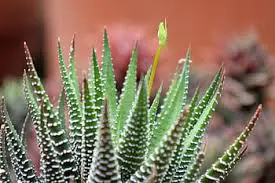
Another great indoor plant is the zebra haworthia which is also known as the zebra cactus even though it is not actually a cactus. These plants have white stripes on the outside of their dark leaves. These stripes make zebra hawthoria a good plant to put in fun, colorful pots/containers.
Haworthias are commonly confused with aloes which is understandable since they both belong to the Asphodeloideae family. However, aloes and haworthias are not the same things. Unlike aloes, haworthias are always small and grow very slowly.
The zebra hawthornia can go for weeks without water. They only need to be water once a week if you are growing indoors. During the wintertime, allow the soil to completely dry out before watering.
Make sure you place your zebra haworthia in a location that receives at least 4-6 hours of sunlight in the morning.
These plants are not very tolerant of cold temperatures. If you live in an area with frigid winters, consider moving your zebra haworthia away from windows and putting them on a heating pad.
Another great thing about zebra haworthia is that it is not toxic to cats or dogs!
Echeveria

Echeveria is a large genus of rose-shaped succulents in the Crassulaceae family. They come in a wide variety of colors. Most species grow to be a few inches across.
These succulents like full sun, so they will do best near a sunny window.
During the warmer months, water your Echeveria thoroughly once every week or two. Allow the soil to completely dry between waterings. Reduce water during the winter months. Never allow water to sit in the rosette as this can cause rot or fungal disease.
It is typically easier to propagate Echeveria from leaf cuttings rather than stem cuttings. Simply place lead in a dish that contains some well-draining soil. Then cover the dish until the leaf sprouts.
Make sure you remove the dead leaves from the bottom of the plant. These dead leaves attract pests like mealy bugs.
Fishhook Senecio
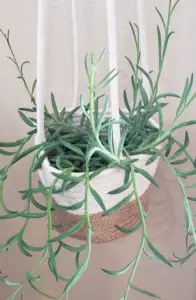
Senecio radicans, which are also known as Fishhook Senecio and string of bananas, are trailing succulents that grow very quickly. The small, pointed leaves of Fishhook Senecio grow in a single file along the cascading stems. They produce tiny flowers during the fall and winter.
These succulents should be placed in an area with bright sunlight. Fishhook Senecio will become leggy or stretched out if they do not receive enough light.
Plant Fishhook Senecio in well-draining soil and make sure you are using a container with at least one drainage hole.
Only water when the soil is dry during the summer months. During the cooler months, water less frequently. Allow the soil to remain dry for a week between waterings.
Fishhook Senecio is considered toxic, so be careful if you are growing these around children or pets as the shape of the leaves can be inviting.
Golden Sedum
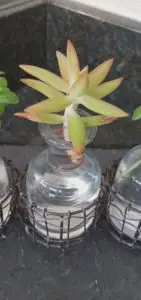
Sedum is a large genus of flowering succulents within the Crassulaceae family. It is comprised of nearly 600 species of succulents with varying heights, colors, and shapes.
One of my favorite succulents is the golden sedum (Sedum kamtschaticum) because its colors are very striking. They grow very quickly and produce tiny, yellow flowers. Golden sedums are a low-growing succulent that has many rosettes on each stem.
Firestone sedum is a cultivar of golden sedum that has even more striking colors.
Golden sedums are low-growing succulents that do well indoors. They need at least six hours of sunlight per day. During hot summer weather, make sure these succulents are in an area with some shade in order to prevent leaf burn.
Like other succulents belonging to the Sedum genus, golden sedums will lose some of their color if they are not getting enough light. If the leaves of your golden sedum start to fade to green, place your plant in a sunnier location.
During the spring and summer, water golden sedums thoroughly every week or two. Allow the top inch of soil to dry completely between waterings. During the winter, you should only start to water your golden sedum if the leaves start to pucker.
Sedums are generally not toxic to cats and dogs.
Lithops
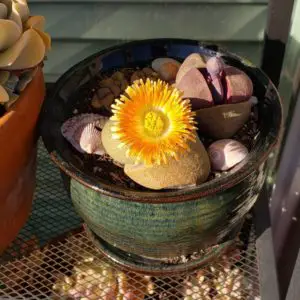
Lithops are also known as living stones. They have become very popular due to their unusual appearance and because they require very little maintenance.
Lithops are native to the dry regions of southern Africa. In the wild, they blend into their natural surroundings. This prevents grazing animals from eating them in order to extract the moisture from the plants.
Ideally, you should place your lithops near a south-facing window. However, an unobstructed east-face window is a good alternative (Crisan et al. 2015). Make sure they are not too close to a window during cold winter weather.
Plant your lithops in a well-draining soil that contains very little organic matter. My lithops have been growing in a cactus soil mix for about two years and have been thriving. However, some people successfully grow their lithops in 100% gravel.
In general, I recommend watering your lithops once or twice a month. If you live in a humid climate, water your lithops once a month. During certain parts of their growth cycle, you should water them even more infrequently.
To learn more about lithops, check out my article on how to care for lithops.
Gollum Jade
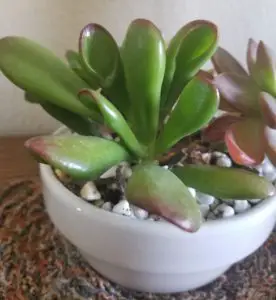
Carassula ovata ‘Gollum,’ which is also known as Gollum jade or finger jade, is a plant with tubular green leaves with red tips. As you may have guessed, these plants are named for the character in JRR Tolkein’s Lord of the Rings books. These plants will produce little pink flowers during late fall and early winter, and they can be grown as bonsai trees.
Water your Gollum jade frequently during the spring and summer. Allow the soil to completely dry out between waterings. Cut back on watering in the fall and water very infrequently during the winter (once every month or two).
This species of succulent is very sensitive to overwatering, so it is better to err on the side of under-watering.
Plant your Gollum jade in a pot containing well-draining soil. Ideally, use a mixture of cactus soil and sand.
Gollum jade will do well in partial sun, but it does best in full sun. Ideally, you should place the plant in a sunny window.
Once Gollum jade is mature, it is easy to propagate it from stem cuttings. Simply obtain a stem cutting and allow it to dry for a day or so. Dip the end of the stem in rooting hormone and place the stem in well-draining soil.
Gollum jade is toxic to dogs and cats. It can cause vomiting. In addition, these plants are mildly toxic to humans. If ingested, it can cause diarrhea and vomiting. For these reasons, keep Gollum jade plants out of the reach of children and pets.
String of Pearls

Senecio rowleyanus, which is commonly known as string of pearls, is a flowering plant that is a member of the daisy family Asteraceae. These gorgeous, cascading succulents look stunning in a hanging basket and add a little flair to any home decor.
Like most succulents, string of pearls is drought tolerant. You only need to water these plants once every one to two weeks. When you water, soak the soil thoroughly.
String of pearls are very sensitive to overwatering. To avoid overwatering, make sure the top 1/2-inch of soil is dry before watering again.
Place your string of pearls in an area that is exposed to the bright morning sun. However, you should take care not to place your string of pearls in an area that is too sunny because these plants burn easily.
String of pearls also grow quickly and are easy to propagate. Simply take some stem cuttings and put the leaves in moist soil. These leaves should root quickly.
In addition to their stunning foliage, string of pearls produce small white flowers that smell like cinnamon. To encourage the growth of these flowers, cut back on watering during the winter months and move them to a slightly cooler area (60°F).
Unfortunately, string of pearls is toxic to cats, dogs, and humans if ingested. Keep this in mind if you have pets or children living in your home.
Ox Tongue
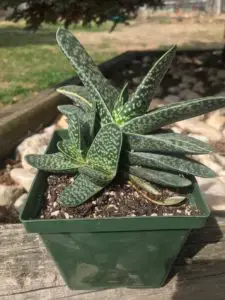
Gasteria verrucosa, which is commonly known as ox tongue or cow’s tongue is named for the sac-like shape of its flowers which look like a stomach.
The genus Gasteria is native to South Africa. In the wild, they grow in places that are lightly shaded with good drainage. As a result, they have adapted to low-light conditions. Place your ox tongue in a location that receives bright indirect light. Many indoor gardeners find that ox tongue does well in cool rooms with limited sunlight.
If you start to see your ox tongue turn white or yellow, that is an indication that they are getting too much sun.
During the summer, water your ox tongue evenly and generously after allowing the soil to dry out between waterings. During the winter, reduce watering to once every two months. Never allow water to pool between the leaves, and make sure your ox tongue is growing in a container with well-draining soil.
Fertilize your gasteria once a year during the springtime.

